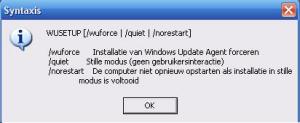Content Type
Profiles
Forums
Events
Posts posted by erik_demon
-
-
The trick to beat the WHQL signing is to put this line in your winnt.sif:
[Unattended]
DriverSigningPolicy= "Ignore"Although this does work for most drivers, it doesn't seem to work for videocard driver (well, not for me, i still had to accept it)
Also WatchDriverSigningPolicy.exe doesn't seem to work.
I am also very earer to learn how to solve this (so I can use forceware version 77.76 instead of the crapy 77.72)
Who can help us?
0 -
@Bashrat
Couldn't this (however modified) replace the current KtD method in DP Base:
For method 2 this would mean:
@presetup.cmd stage extract the DP's
@DetachedProgram stage run the autoit scriptThis would have the following advantages:
- no limitations to the OemPnPDriversPath problem
- no double work, this way we don't have to use SetDevicePath and SetupCopyOEMInf which safes (a little) time
I believe that this would be quite an improvement

(hp38guser mentioned this before though
 )0
)0 -
@Yzöwl
You have a point here, this is my misstake. I will explain it

My unattended structure at home is so that I am able to install from a CD, from a second harddisk and from a network share.
To not complicate things, to keep everything simpel, I work with only one variable. This variable is %CDROM%.
In my test the file called cd.txt was on my second harddrive ( D:\ ) therfore this harddrive is seen as %CDROM% and the batch file will tell you
Your CD-rom drive is: D:

I understand your confusion completely an when I get back from vacation (ah finally
 ) I will change it, because like you stated, it is not possible to write or delete to the optical drive.0
) I will change it, because like you stated, it is not possible to write or delete to the optical drive.0 -
sorry for the late answer, I didn't pay attention to the topic

I do not completely understand what you mean:
how are you both 'echoing to' and 'deleting from' the optical disk drive?I believe that you think that I use this for a CD based installed, correct?
If you mean that, it will not work. I install my computer from a second harddrive. On that drive, I can write and delete as much as I like.
You are correct when you say that this won't work with a CD install.
However...
If you change the batch file like this:
ECHO AutoPartition=1 >>%CDROM%WINNT.SIF
to
ECHO AutoPartition=1 >>A:\WINNT.SIF
the winnt.sif will be written to a Floppy disk. Then you could modify the batch file to let winnt32.exe find the answer file there
I hope this helps
0 -
Problem 2 is solved. I needed to upgrade my homenetwork to 54Mbit anyway, so I bought a new WLAN card which has WHQL driver

Problem 1 still exists. I tried to connect to the share with WEP-key disabled and it worked just great. When it is enabled it doesn't work at all.
Is there anyone who knows a network bootdisk that can handle a WEP-key?
0 -
Hey guys

The last few days I became very interested in doing a network install for my two computers at home. I modified my unattended so that it should work just great. I now however have two big problems.
I will first explain what I want to do:
I want to use a BART PE cd (with network plug-in) or another network bootdisk to boot the first computer. Then it should connect with a share on the other computer.
This shouldn't be too difficult for a wired network. The problem is that I have a wireless network.
Problem 1:
To protect my wireless network I use WEP protection. In order for the data to pass my accespoint I need to use a WEP-key. In the network bootdisks I mentioned earlier on, there was no option to use a WEP-key. This means that it is not possible to have a wireless connection with WEP protection enabled.
Possible solution: temporarily disable WEP protection (but I would rather not do that)
Question: Is there a network bootdisk that gives you the ability to set a WEP-key?
Problem 2:
One of the WLAN cards in my network (the card with the computer that I want to install on) has driver that are Not WHQL. This brings up the problem that this network adapter can't be found by the BARTPE (with network plug-in) disk.
Possible solution:
1. Change wireless card so that the computer that needs to be installed has WHQL drivers.
2. Buy a new wireless card just to get WHQL drivers

Question: Is there a network bootdisk that can work with NON-WHQL drivers?
0 -
-
Thanks for this info, I now have a second comp. in my wireless network. And I plan to install it unattended. Very usefull, thanks
 0
0 -
-
I don't know about a switch, I don't use Setpoint drivers or application. All I know is that there is an Autoit script available. It is posted by Volkonov4 in your other topic. I know that it isn't what you would like, but it should be working so why not

EDIT:
maybe this topic can help your out
0 -
Maybe if you download and install the full version (or redist version) of DC 9.0c it will work.
You can download it here
EDIT:
And if you use XP, upgrade to SP2, it has directX 9.0c insite
0 -
@dziubek
Thanks,
KB884883 is already at V8, when I downloaded the new version, the filesize went up from +- 1MB to +- 4MB

The problem is that when a KB nr. is upgraded to a new version (like for KB884883), it isn't shown on windows updates (well execept for KB893066 and Windows installer) . So if you intergade them, or install the updates with a batch file you are still working with an older version.
This is why I redownloaded all hotfixes again. Below you can find an attachment with the results.
hotfixes with an "!!!" behind it have been upgraded to a higher version nr.
Note that this list is for a dutch version of XP
@Nilfred & dziubek
Indeed KB884020 isn't needed anymore, I did a fresh install yesterday without KB884020 and there where no new windows updates
0 -
Hey Welcome to MSFN
 so i pressume the $OEM$ folder is ment to be copied to the c:\root ! is this correct !
so i pressume the $OEM$ folder is ment to be copied to the c:\root ! is this correct !This is not entirely correct. If you want to copy some files to the root of the drive where windows is installed (for you is that the C drive), you have to create a folder inside the $OEM$ folder. This folder is called $1. Your structure should now look like this:
$OEM$\$1\install\enz
for more info about this, please check-out this page
For more info about the RunOnceEx, look here
and if you want to install directly from the CD, look here (this however is a bit more diffecult, I would recommend you to start with the link above first.
Good luck!!
0 -
It is strange, for some people (like me) [Components] is working, for other people, it does not. Is [Components] depending on another alue in the winnt.sif in order to work?
0 -
Could you please check if this ...
[OptionalSrcDirs]
SVCPACK... is in your dosnet.inf?
EDIT:
I believe Nlite does this automatic, and I think the /intergrade switch does this aswell, but it is just to be on the safe site
0 -
It doesn't work for me

Bastian_W, what is download.exe? It doesn't seem to be in winxp.
0 -
Very nice, thanks
 0
0 -
@Nois3
This is great thanks

I do have a question now
ECHO The encrypted key will be valid for *30* days.Could you please explain this, does this mean that after 30 days, your windows stops functioning, and you need to reaply your serial?
EDIT:
or does this mean that in 30 days your CD won't accept the code?
0 -
hey

I believe you can put it every where between...
REM Example, how to look for CDROM-drive. Must have a file to identify in its root (like WIN51 or WPI.ico).
for %%i in (C D E F G H I J K L M N O P Q R S T U V W X Y Z) do if exist %%i:\win51 set CDROM=%%i:
echo Found CD-Rom as drive %CDROM%and...
REM Start WPI and wait for its end
start /wait \wpi\WPI.htaIf you would like to, you could even start it from inside your WPI
0 -
Hi

First things first, please remove your serial key (I already collected two keys on this board today

 )
)I don't know much about network installs but i will try to help
Do you get any errors?
Maybe this topic can help you out
0 -
Hey

this is why it doesn't work:
OemPreinstall=No
should be
OemPreinstall=YES
EDIT
IMPORTANT: Please remove your serial key
0 -
don't know, for me it opens just fine
 0
0 -
Glad I was able to help

about the winnt.sif creation thing,
I updated my method so that it now creats a (simple) winnt.sif
Check it out here
If you want it to work on a floppy disc, select from line 142 to 195, and replace all %CDROM% to A:\
EDIT:
line 142 should be
ECHO;SetupMgrTag >>%CDROM%WINNT.SIF
and line 195 should be
SET answerfile_name=winnt.sif
0 -
Hey Welcome to MSFN

Your winnt.sif is okay
When you install from a CD, your $OEM$ has to be parallel to your i386 folder.
When you install by using winnt.exe or winnt32.exe your $OEM$ for has to be inside the i386 folder (like you have now)
EDIT:
a tip:
You are using $OEM$\C\firstrun
Using $OEM$\C is only intersting if you want to copy specific things to specific drives, like for instance: $OEM$\C\firstrun and $OEM$\D\Other_crap. Instead of $OEM$\C you could also use $OEM$\$1 because $1 will copy everything inside to the drive where windows is installed
0




Drivers from CD: Simple Method
in Device Drivers
Posted
I believe we can if we do it this way